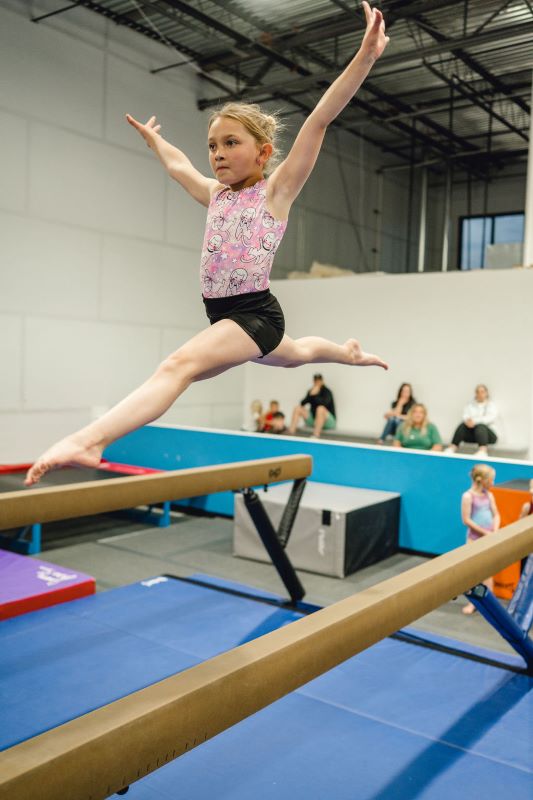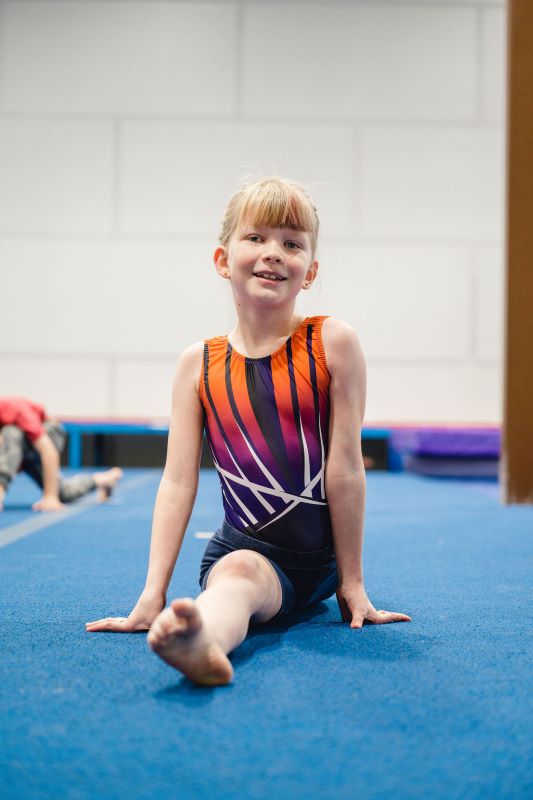Introduction
Leaps are an essential element of any gymnast’s routine, combining grace, power, and flexibility. Whether you’re performing on the floor or on a beam, a well-executed leap can elevate your routine and showcase your athleticism. However, mastering leaps requires more than just a powerful leap; it involves perfecting your form, timing, and control. In this guide, we’ll help you break down the components of a perfect leap, address common challenges, and offer tips to enhance your leap skills.
Understanding Gymnastics Leaps
Gymnastics leaps are complex movements that can vary greatly depending on the type of leap that you are attempting. The most fundamental leap in any gymnast’s arsenal is the split leap. This skill involves launching off one foot, extending into a full split in the air, and landing gracefully on the opposite foot. There are many other skills like this but most are similar variations to this core skill.
Different Types Of Gymnastics Leaps:
- Split Leap: A leap where the gymnast performs a full split in the air, emphasizing flexibility and height.
- Switch Leap: A leap that begins like a split leap but switches legs mid-air before landing.
- Stag Leap: A split leap variation with one leg bent and the other extended straight.
- Wolf Leap: A leap where one leg tucks under the body while the other extends outward.
- Tour Jete or Turning Leap: A turning leap where the gymnast rotates 180 degrees mid-air while performing a split.
- Sheep Leap: A leap where both legs bend backward, aiming to touch the feet to the back of the head.
- Cat Leap: A leap where both legs are bent and lifted in a hopping motion, often used for transitions.
- Straddle Leap: A leap with legs extending sideways into a straddle position in the air.
- Ring Leap: A leap where one leg bends back toward the head while the other extends forward, creating a ring shape with the body.
These common types of leaps each require precise techniques and proper body positioning to be executed flawlessly. Beyond their aesthetic appeal, leaps play a crucial role in routines, connecting elements and enhancing artistic value. They are a testament to a gymnast’s flexibility, strength, and control, showcasing their overall athleticism and skill.

Preparation and Prerequisites
Before attempting to master your leaps, it’s essential to ensure that you have the necessary strength, flexibility, and body awareness. Key areas to focus on include:
- Flexibility: The ability to achieve a full split on the ground is required for performing effective leaps. Regular stretching exercises, such as lunges, hamstring stretches, and hip flexor stretches, are important to maintain and improve your flexibility.
- Leg Strength: Powerful leaps require strong leg muscles, particularly in the quads, hamstrings, and calves. Exercises such as squats, lunges, and calf raises can help build the necessary strength. Be sure to train explosive movements as the leap itself will require these fast twitch muscles.
- Core Stability: A strong core supports balance and control during the leap. Incorporate exercises like planks, hollow holds, and leg lifts into your training routine.
- Balance: Practicing balance exercises on the beam or floor can help improve your landing and reduce wobbles or falls.
Step-by-Step Guide to Performing a Split Leap
- Approach and Takeoff:
- Start with a controlled run-up or series of steps to build momentum.
- As you approach your takeoff point, prepare to push off from one foot while keeping your body upright.
- Swing your arms upward to generate lift, and focus on a strong, explosive push-off from the ground.
- Achieving the Split Position:
- As you leave the ground, extend your legs into a split position. Raise your non-jumping leg at the same time that you extend your jumping leg upwards attempting to achieve a full 180-degree split in the air. For different leaps this position could vary.
- Keep your toes pointed, legs straight, and arms extended to maintain balance and create a beautiful line.
- Engage your core and keep your upper body lifted to avoid leaning forward or backward.
- Mid-Air Control:
- Focus on maintaining your split position for as long as possible while in the air.
- Keep your gaze forward, and ensure your hips stay square to avoid twisting or uneven splits.
- Landing:
- As you begin to descend, prepare to land softly on the opposite foot from your takeoff foot.
- Absorb the impact by bending your knee slightly, and use your arms to help maintain balance.
- Aim for a controlled, stable landing with minimal movement.

Common Mistakes and How to Avoid Them
Mastering a leap can be challenging, and many gymnasts encounter common mistakes along the way. Here are some typical errors and tips on how to avoid them:
- Insufficient Height: Failing to generate enough lift can result in a low leap without enough time to reach your splits. Ensure you push off the ground powerfully and use your arms to help create upward momentum.
- Bent Knees: Keeping your legs straight during the leap is essential for a clean, aesthetically pleasing line. Focus on engaging your quads and pointing your toes throughout the leap. This of course will vary depending on the leap.
- Twisting Hips: Uneven splits or twisted hips can make the leap look unpolished. Practice maintaining square hips during splits on the ground to help translate this into your leap.
- Uncontrolled Landing: A wobbly or unstable landing can detract from the overall quality of the leap. Work on your balance and leg strength to ensure a controlled, graceful landing.
Expert Tips for Mastering Leaps
Learning from experienced gymnasts and coaches can significantly improve your leap technique. Here are some expert tips to help you leap to new heights:
- Drills and Progressions: Break down the leap into smaller components, such as practicing takeoffs, mid-air splits, and landings separately before combining them into a full leap.
- Use a Spotter: Work with a coach or spotter to help you understand the correct body positioning and provide feedback on your form.
- Practice on Different Surfaces: Train your leaps on both the floor and beam to improve your versatility and adaptability.
- Consistency is Key: Regular practice is essential for mastering leaps. Incorporate leaps into your daily training routine and gradually increase the complexity of the leaps you perform.
Conclusion
Mastering leaps is a vital skill for any gymnast, adding elegance and energy to your routines. By understanding the mechanics, preparing your body, and practicing consistently, you can develop powerful, graceful leaps that will impress judges and audiences alike. Remember to focus on each phase of the leap, avoid common mistakes, and seek guidance from experienced coaches to refine your technique. Keep leaping to new heights, and enjoy the journey of perfecting this essential gymnastics skill!
Additional Resources
For further learning, check out these helpful video tutorials:
- GymnasticsHowTo: Perfect Your Split Leap
- How to Improve Your Split Leap
- How to do Basic Rhythmic Gymnastics Leaps
Good luck with your leaps! If you ever need extra guidance, our coaches at Elevate Sports Center are here to help. Don’t hesitate to reach out—we’re always ready to support you in achieving your gymnastics goals.
Try it FREE!
We offer one free trial class to all students who are interested in our programs. From NinjaZone to Tumbling, give one of our classes are shot. After all…. it’s FREE!


